Menu
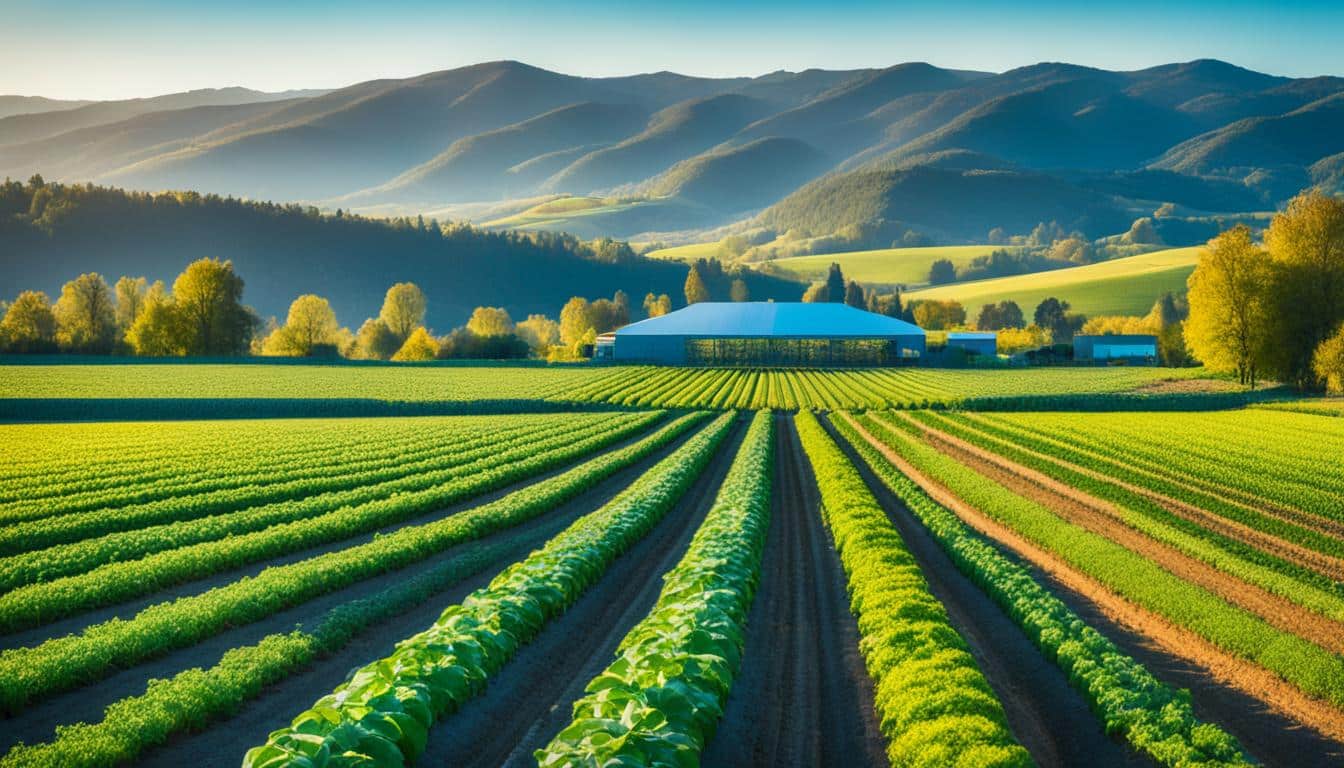
“The soil is the great connector of lives, the source and destination of all.” – Wendell Berry
Crop rotation is like a guiding light in farming responsibly. This method helps the earth and makes our farms strong. We plant different crops one after the other. This way, soil gets better, pests stay away naturally, and our farms stand strong. Studies from places like the Rodale Institute show how important crop rotation is. It keeps the soil healthy and stops bad bug and disease cycles.
There’s all sorts of ways to do crop rotation. You can have simple plans with just two crops or more complex ones with many types. Adding things like alfalfa and wheat, besides the main crops, makes the soil healthier. Also, keeping some parts of plants on the ground can stop the land from washing away. This means we can use fewer chemicals, make our farms welcome to good bugs, and follow organic rules properly.
Crop rotation means planting different crops in order on the same plot. Patterns can range from two or three plants to many, taking up to eight years to complete. This system looks after the soil and helps farmers manage their land well over time.
It’s vital to know the main ideas behind crop rotation. By changing what’s planted, the soil gets better. This can be by adding back what’s missing or using up what’s too much, making the earth even. It also makes the soil easier for plants to grow in, allowing more water and air to get to the roots.
Plants that leave lots of bits behind, like maize or hay, can protect the soil from being washed away by rain. This method can also make crops grow better. It helps them handle tough times and lift their yield. Using some specific plants (like beans) can act like a natural fertiliser, which is better for the soil than the synthetic kind.
Planning how you rotate crops is a key step. It can stop pests and diseases from finding a home and cut down on the need to use chemicals. Crop rotation also means there are less weeds, saving the farm effort and cutting back on nasty chemicals. This method makes water use on the farm smarter, as it keeps the soil in good shape and needing less water.
But, doing crop rotation right takes know-how. It’s easy to do it wrong and make the soil too rich in some things. So, doing it right needs to be your number one rule. It’s not just about the plants, but also about when and how to plant them. This all can be hard work, needing both time and money.
Good planning involves rotating plants based on their family or what bit we eat. This careful approach is key to successful crop management. There are groups, like Organic Crop Consultants, that can help. They show that each farm needs its own special plan.
Crop rotation is a key practice in farming today, more vital than many realise. It does much more than just improve how much we grow. Each crop needs different nutrients and faces its own pests. By changing crops regularly, we can keep the soil healthy and cut down on pest problems.
Using a mix of crops helps the soil stay strong. Plants like alfalfa and grains, including wheat, all contribute to this. They cover the soil at different times and have different kinds of roots. This mix helps the soil in ways a single type of crop cannot.

Studies, like those by Ball et al. (2005), show how crop rotation improves soil and stops it from eroding. Growing plants to cover the soil in wintertime makes it stronger. Government support for growing different crops is vital for a healthy environment.
Diverse crop rotations make the farming system better at handling problems. Li et al. (2019) found that varied crops help the farm fight off troubles well. Experts like Mohler and Johnson (2009) say mixing up crops keeps the soil healthy.
We can plan planting many types of crops over three to ten years. For example, four-year plans add beans, root veg, and salads. The variety clears out weeds and boosts the health of the land.
This strategy is a winner for both the farm and the planet. It cuts costs, adds variety, and boosts earnings, as noted in studies. Using different crops helps the whole farm thrive for the long term.
Finally, crop rotation supports healthy soil and cuts erosion. It helps move us away from growing one thing on a field. This change is good for the land, good for the crops, and good for the future.
| Crop Type | Sowing Time | Benefits |
|---|---|---|
| Alfalfa | Spring | Enhances soil structure |
| Wheat | Fall | Reduces soil depletion |
| Barley | Spring | Increases organic matter |
| Mustard | Winter | Pest deterrence |
Using crop rotation helps improve soil health and makes farming sustainable. This old method dates back to 6000 BC. It has always helped keep soil healthy and crops growing well. Different types of crops in rotation bring various advantages to the soil. They can increase organic matter and stop soil from being washed away.
Growing different crops one after the other helps increase soil organic matter. Each type of crop leaves behind different roots and leftovers. This helps the soil become better and have more types of helpful microbes. For example, a four-year plan might include legumes, root veggies, fruits, and greens. This mix can really make the soil a healthier place for microbes.
These varied crops encourage more microbes in the soil. This makes the soil richer and more alive. Farmers who mix up their crops every ten years see more crops and more money. Swapping crops often is a smart way to farm.
Stopping soil from being washed away is a big deal in farming. Crop rotation really helps with this. Different crops have roots that hold the soil together and stop water from washing it away. About 60% of this washed-away soil ends up polluting our water in places like the Midwest.
Good soil care tricks like crop rotation help keep the soil safe from washing away. This is super important when it rains a lot. By using less chemicals, crop rotation also keeps our waters cleaner. It protects both the land and the water we need to survive.
Below is a table showing why crop rotation beats sticking to one crop:
| Aspect | Continuous Cropping | Crop Rotation |
|---|---|---|
| Yield Improvement (%) | – | 29% (2-year rotation), 48% (4-year rotation with legumes) |
| Soil Erosion | High | Low |
| Need for Fertilisers | High | Reduced |
Crop rotation is key to keeping soil healthy. It helps fight soil loss and boosts farming’s long-term success. By using this method, farmers can improve their farms and their finances. It’s a powerful tool for sustainable and successful farming.
Crop rotation is key for keeping pests under control. It involves changing the crops grown in an area each season. Farmers do this over a three to ten-year period. It works wonders for pest control, cuts down on chemicals, and has other bonuses.
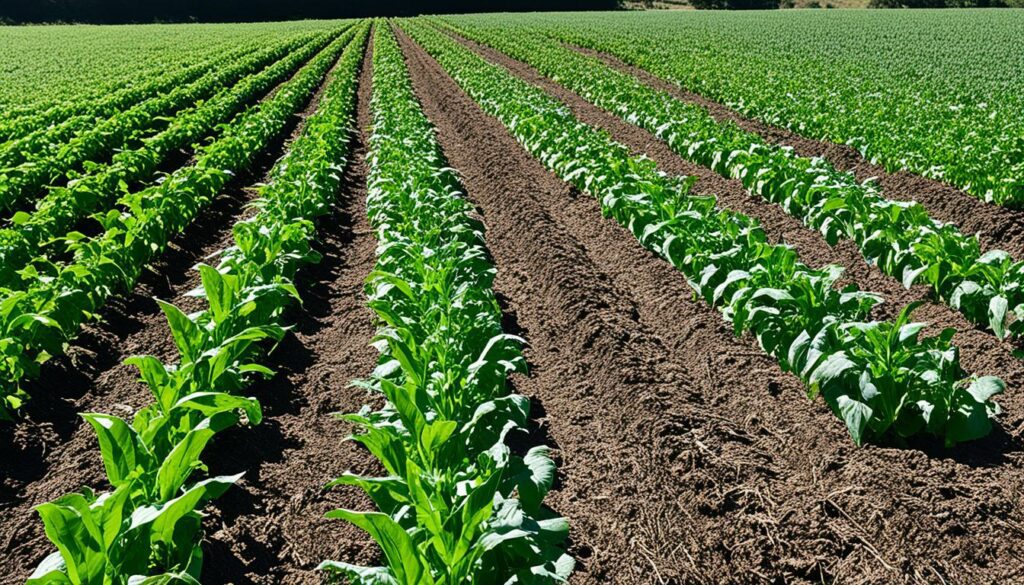
Crop rotation stops pests from getting too comfortable. When you grow different crops, bugs that love one type can’t stick around. This helps keep their numbers low. Plus, it stops soil from getting too many harmful microorganisms.
Studies back this up. They show that rotating crops can cut down on pests and disease. This means farmers don’t need to use as many chemicals, a huge win for the environment.
Less chemicals is another big win from crop rotation. By growing crops in a thoughtful order, farmers don’t need as much help from artificial stuff. This approach has shown to lower the use of fertilisers and pesticides.
It’s not just good for the Earth. Using crop rotation can save farmers money. Besides cutting down on expenses, it also boosts soil health and farm earnings. This makes it a great choice for both the planet and those working the land.
Growing different crops one after the other can bring many economic advantages of crop rotation. It helps farmers spend less, which makes their farms more profitable and sustainable. This cost-saving cycle spans reducing fertiliser use and finding more efficient ways to farm.
One major benefit of diversified cropping systems benefits is less spending on pest and disease control. This change comes from using fewer pesticides, making the soil richer and cutting down on fertilizer costs. Farmers then can use this saved money to plant crops worth more, finding new markets and profits.”
Studying the soil shows that crop rotation truly makes it better. It does this by moving nutrients around, reusing old plant parts, and creating natural tunnels in the ground. This helps the soil work better, reducing the need for added chemicals. Also, swapping crops messes up pests’ plans, lowering the use of harmful pesticides and making the environment better.
Starting to rotate crops might be tricky, needing some know-how and the right tools. But, once in place, this strategy can fit well with farm work, bringing in good money and making farms more profitable and sustainable.”
Less spending on farming stuff plus the chance for more harvests really shows the value of crop rotation. This method can keep farms making money in the long run, no matter their size.”
Crop diversity is key in sustainable farming. It brings many environmental benefits. Farmers grow various crops like alfalfa, pasture, and grains. This mix helps the soil by adding different root systems. It also keeps the soil healthy with more organic matter and better water holding.
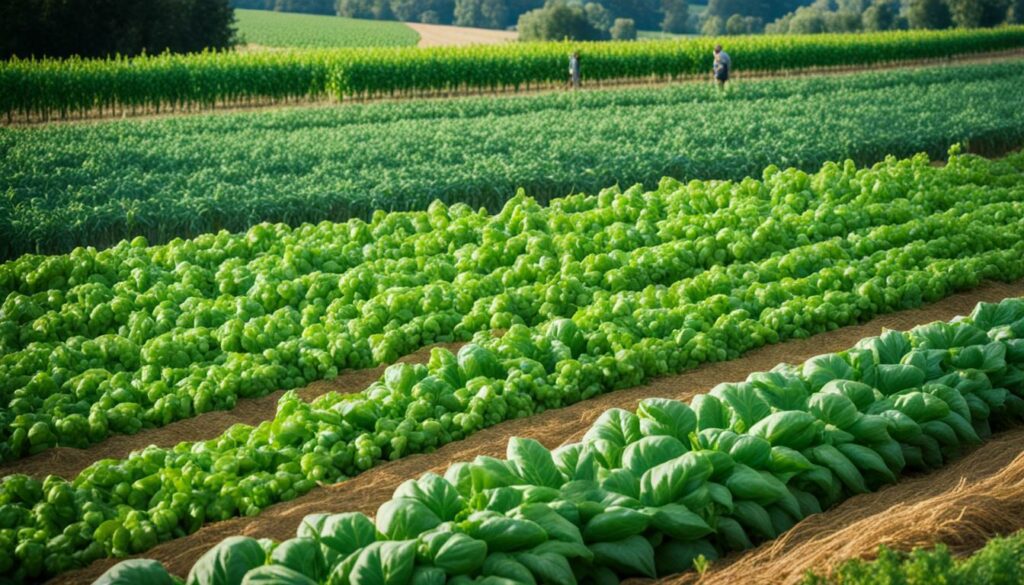
Using a variety of crops has more perks. For example, soybeans next to corn help by adding nitrogen to the soil. This makes the soil richer and ready for other crops. Studies prove this mix of crops also makes the land better for manure use and with less tilling, meaning farming is stronger and more fruitful.
Research shows mixed crops give a better profit than just planting corn and soybeans. Using various crops improves the soil’s health and growing power. It’s key to have a mix of plants in the soil to keep it living and rich.
“Diversifying crop rotations ensures conservation of natural resources and reduces production risks, particularly with the rising challenges posed by climate change.”
Studies found that different crops together do better economically than only growing corn and soy. Sustainable farming and using many kinds of crops helps the environment and farmers’ wallets. It’s the best way to ensure both a green future and financial success for farmers.
The crop rotation history shows how farming has advanced for centuries. It all began in ancient times, with the Romans using two-field systems. This helped them grow more food. Cato the Elder later suggested using two or three fields to grow different crops. This kept the soil health in good condition.
By medieval times, Europe had improved on this. They started to rotate crops between three fields every year. This made the land more productive and efficient. In the 17th and 18th centuries, European farmers got even smarter. They started using longer rotations and added crops from the Americas, like maize and potatoes.
In the 18th century, Charles Townshend introduced a four-year plan with wheat, turnips, barley, and clover. This showed that using different crops is really important. In the USA, George Washington Carver also encouraged this. He knew growing only one crop, like cotton, was bad for the soil. Carver suggested using peanuts and sweet potatoes instead.
Today, we still use these old farming ideas. Crop rotation helps reduce chemical use and keeps the soil healthy. This way, we can farm more efficiently and in a more sustainable way. Let’s see exactly how these advancements in crop management have changed the way we farm:
| Time Period | Region | Rotation System | Highlights |
|---|---|---|---|
| Ancient China | Eastern Zhou Period | Two-Field | Plant half, leave half fallow |
| 2nd Century BC | Rome | Two-Field, Three-Field | Recommended by Cato the Elder |
| Medieval Europe | Europe | Three-Field | Annual crop rotation |
| 1700s | Europe & Americas | Four-Field, Five-Field | Introduction of maize, potatoes |
| 18th Century | Norfolk, England | Norfolk System | Wheat, turnips, barley, clover |
| Early 20th Century | USA | Various Systems | Promoted by George Washington Carver |
These ancient and old systems have enriched the history of crop rotation. They also highlight how farming has progressed. Today, we continue to refine and use these ancient farming methods. They have shaped today’s crop management advancements beautifully.
Crop rotation boosts soil health by making better use of nutrients and improving nitrogen levels. This old farming method helps plants get what they need from the soil. It makes farming more balanced and reduces the need for man-made chemicals.
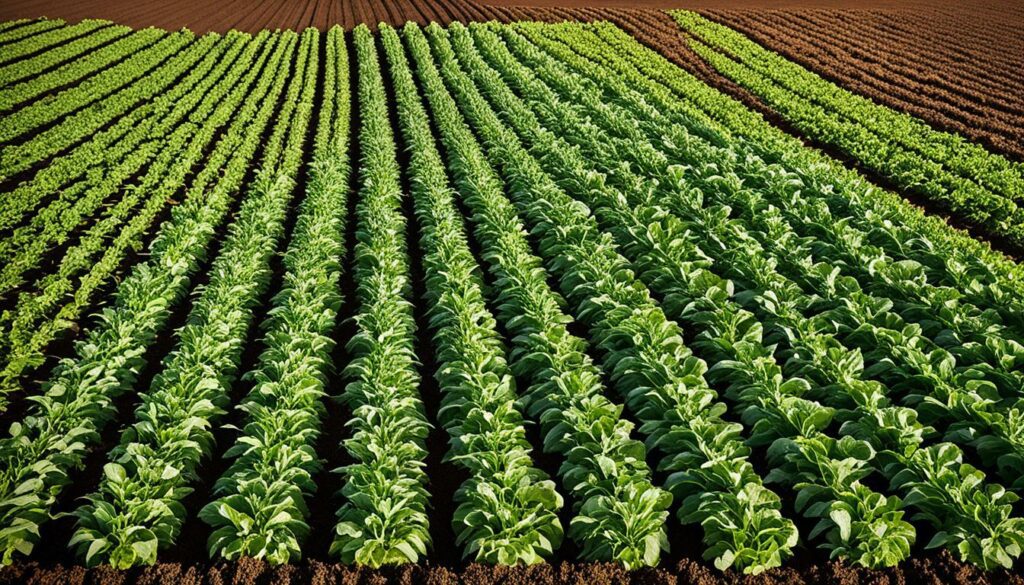
One key advantage of crop rotation is better nutrient use. By switching which plants grow in a field, we prevent the soil from losing certain nutrients. For example, we plant beans after corn. Beans add nitrogen back into the soil. This keeps the soil ready for more crops to grow well.
Beans and peas are important because they add nitrogen from the air to the soil. They do this with the help of special bacteria in their roots. This way, the soil gets more fertile without using chemical fertilisers. It’s good for the environment too.
There are clear benefits from using crop rotation. For example, fields that rotate crops saw a 29% increase in corn yields. Another study found a 48% boost in corn production over four years by including a year of legume cover crops. These numbers show how crop rotation is key to big improvements in farming.
Using crop rotation can save farmers money on buying fertilisers and pesticides. It’s also often free to learn how to do it thanks to the Natural Resources Conservation Service. Plus, there are government programmes that help farmers start using crop rotation.
| Major Benefits | Impact |
|---|---|
| Increased Corn Yields | 29% improvement in two-year rotation |
| Enhanced Yields with Legume Cover Crop | 48% increase during a four-year rotation |
| Reduced Input Costs | Lower fertiliser and pesticide requirements |
To succeed in crop rotation, you need to fully grasp the rules and each crop’s needs. This can take up to eight years, with simple two-crop plans or complex twelve-crop systems.
Selecting the right order and timing for crops is key. You must think about soil quality, past pest problems, and what you seek to achieve on the farm. Expert advice from farmers is invaluable.
Ball et al. (2005) showed how crop rotation can improve soil health. Meanwhile, Jankauskas & Jankauskiene (2003) demonstrated how it prevents soil erosion. Li et al. (2019) found that mixing up crops boosts the system’s strength, ups the yield, and cuts risks.
“In-depth knowledge and careful planning are vital for rotational farming methods to be effective. Inadequate implementation can lead to soil nutrient overload, whereas well-planned rotations enrich soil and support sustainable farming.”
Crop rotation is also great for fighting off pests and diseases. It stops these from spreading and means you need less pesticide. Simić et al. (2016) noted that it also fights weeds by making their life conditions worse.
The following table presents practical guidelines and considerations for crop rotation:
| Aspect | Guideline | Considerations |
|---|---|---|
| Crop Selection | Select a variety of crops for different soil needs. | Choose legumes for nitrogen and root veggies to help with soil quality. |
| Rotation Timing | Change up crops every 3-10 years. | By rotating, you help keep the soil healthier. |
| Pest and Disease Control | Use rotations to stop pests and diseases spreading. | Think about the plants’ pest and disease history when planning. |
| Soil Health Management | Use plants that improve soil by adding organic matter. | Check soil often to keep track of nutrients and organic matter. |
| Water Use Efficiency | Go for crops with different water needs to save water. | Use techniques that keep soil moist. |
Effective crop rotation needs a deep understanding of the ideas and advice from experts. Doing it right improves soil, cuts down on pests and diseases, and helps you farm in ways that are better for the earth.
Although crop rotation is highly beneficial, many farmers find it hard to adopt. They face obstacles like cultural traditions and market demands. They also need the right tools and structures to make it work.
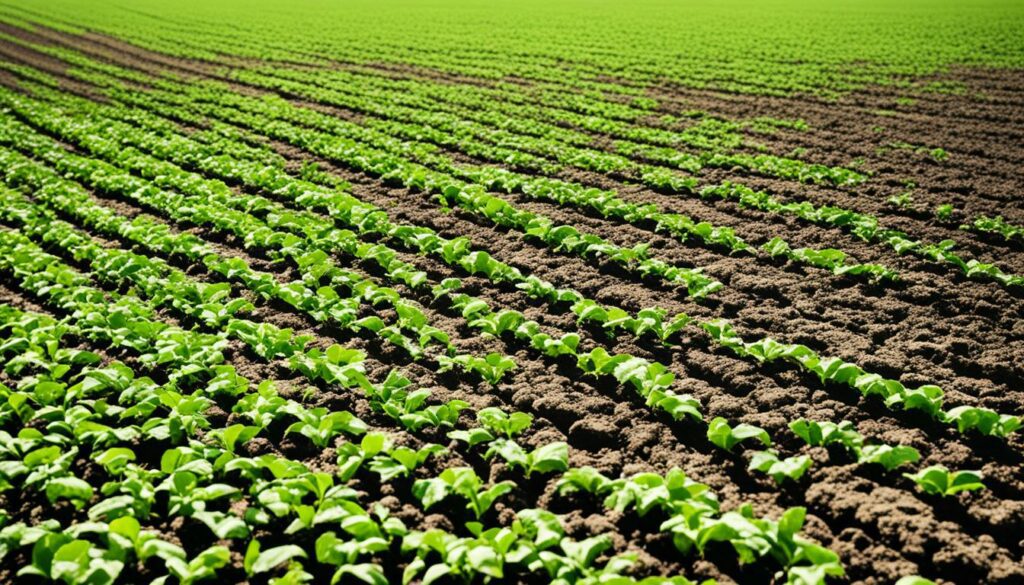
Changing traditions is one of the biggest problems for farmers trying crop rotation. Many old-school farming areas find it tough to move away from their usual ways. Plus, selling the new variety of crops can be a challenge as markets might not be ready for them.
To overcome these issues, farmers can work with experts and other farmers. They can learn about the benefits of crop rotation. Also, they can look for markets that appreciate their diverse crops.
Getting the right tools for crop rotation is not easy. Farmers often need new or adapted equipment to handle different crops. They may also need extra storage for their varied harvests.
Dealing with this need for change can be hard. But, there are ways to get help. Governments offer support like grants or loans for farming improvements. New policies and programmes can also make a big difference.
Handling the challenges of crop rotation requires a mix of solutions. This might include new technology, teaching others about its benefits, and better support from the government. Together, these steps can help farmers succeed with crop rotation.
Crop rotation in the real world shows clear benefits for farms. Pinnacle Organically Grown Produce proves this. They switch their crops each season for three to ten years. This keeps their soil fertile and pest-resistant.
In a study, a two-year crop rotation led to a 29% boost in corn yields. This jumped to 48% with a four-year rotation, and by adding a legume in winter. These findings highlight how crop rotation can significantly increase yields and soil quality.
Rotations can take several years to see full benefits. Full Belly Farm, for example, uses crop rotations over eight years. They rotate between three to four crops annually. This not only keeps the soil healthy but also helps their profits grow over time.
More advanced rotations with up to twelve crops are also effective. They help with nutrient cycling and reduce the risk of plant diseases. Learning from these methods, farmers can make the most of crop diversity. This leads to better soil, water use, and farm success in the long run.
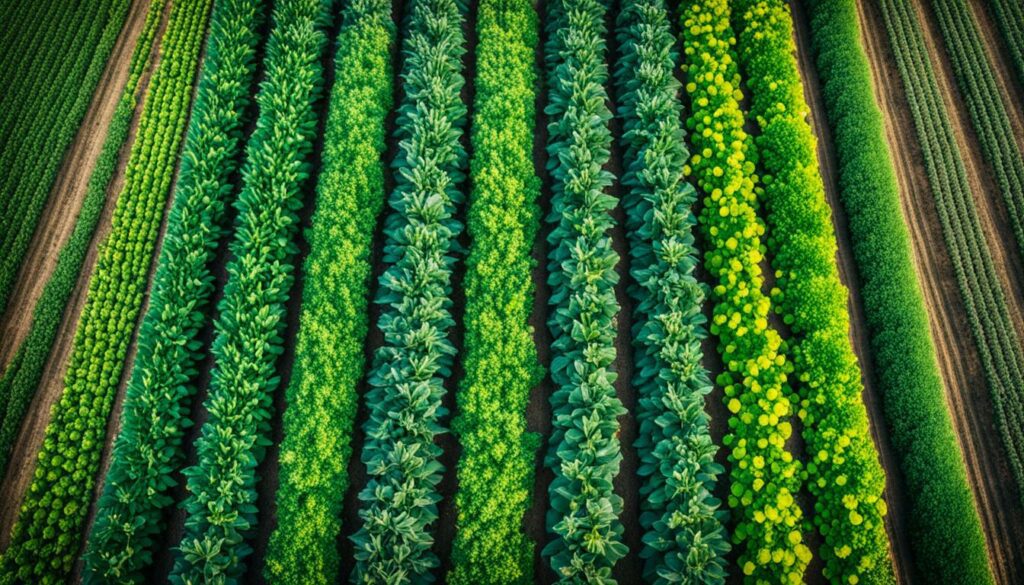
The strategy of crop rotation is key as we tackle climate change. It improves the soil’s ability to store carbon and handles tough weather. This approach is vital for making farming more adaptable to our changing climate. With a typical cycle lasting up to eight years, farmers can utilise plants that need fewer nutrients, reducing synthetic fertiliser use. Add in grasses, cereals, and oil plants, and we cut back on fertilisers and trap more carbon.
Crop rotation boosts how well farms bounce back from challenges. Growing different crops in turns helps farmers get more harvest and lower the risks over time. Check this out: from 2016 to 2021, China increased areas testing crop rotation from 411,000 to 2,667,000 hectares. This change shows a move towards more eco-friendly farming in response to climate change. Science also shows that varied crops help the soil store more water, which is crucial for growing good crops.
This method doesn’t just help with water; it cuts down on pollution too. It lowers the amount of water that runs off the land by 13% and boosts the natural process of plants releasing water by 17.9%. Crop rotation, especially with cover crops like legumes, helps the soil soak up water better. It also reduces soil being washed away. These actions lower the chances of floods by making the land and water systems healthier.
Think about how crop rotation can turn the tide after tough times like 2020’s meteorological disasters in China. These hit about 19,958,000 hectares and caused losses of $57 billion. By enriching the soil and controlling pests better, farmers can use fewer chemicals. This lowers the cost on farms and cuts how much can hurt the environment. Diversifying crops is not only a safety net against bad weather, pests, and changes in the market; it also helps manage water better. This plays a big role in getting farms ready for what our climate might bring.
Crop rotation is crucial for sustainable farming. Studies show that using different crops each year can boost yields. It also makes soil healthier, cuts the need for chemicals, and fights plant diseases. This shows why crop rotation is key for modern, eco-friendly farming.
There are many benefits to crop rotation. It helps manage environmental stress and reduces pests. By using different types of crops, it stops diseases from spreading. This makes farms more resilient in the long run. Plus, calculating the economic gain of this method proves it’s a smart choice.
To farm sustainably, we need to use resources well. Crop rotation makes better use of water by planting various crops. It also improves soil health, increasing yields without harming the environment. Plants like alfalfa help by adding nitrogen, which is good for the soil and future crops.
So, crop rotation isn’t just a tool; it’s a whole farming strategy. It brings profits and helps nature thrive. It’s vital for a farming future that’s both successful and green. By using crop rotation, we can ensure good times for our farms and our world.
Crop rotation means planting different crops one after the other. This practice helps the soil use nutrients better and stops pests and diseases. It is key for keeping the land healthy, controlling pests without chemicals, and cutting down on chemical use.
It makes the soil better in many ways. It adds organic matter and improves how the soil feels. This helps stop soil washing away and keeps more water in the ground. Each crop helps the soil in its own way. So, the soil becomes stronger and more alive.
Changing the crops confuses pests and doesn’t let them get too comfortable. This keeps their numbers down without needing harmful chemicals. Less use of chemicals means a healthier farm.
It cuts down on spending for dealing with pests and diseases and using fertilisers. Plus, it boosts soil quality. A mix of crops could sell better, making farming more profitable. It also opens doors to new markets.
Having different crops means the soil gets more types of food and stays stronger. With this variety, the farm can cope with bad weather or changing markets. It makes farming more reliable and sustainable.
People have known the benefits of crop rotation for a long time. It’s been used for centuries and keeps getting better with new scientific knowledge. So, it’s a proven and smart way to farm.
By planting different kinds of crops, the soil gets many nutrients. For example, some plants can make the air’s nitrogen into food for the soil. This means less need for man-made fertilisers and a healthier soil.
Start by knowing what each crop needs and what your soil is like. Look at what pests have been around and your farming goals. Getting advice from experts or groups like the Rodale Institute can help you plan well.
Some challenges include traditional beliefs, market demands, and the need for different tools. To overcome these, farmers can be creative. They can also look for help from policies and support for sustainable farming.
Farms like Pinnacle Organically Grown Produce and Full Belly Farm show how well crop rotation works. They have both organic and traditional farms. These farms prove that crop rotation is good for the environment and for business.
In the face of climate change, crop rotation is more important than ever. It helps the soil trap carbon and makes farms ready for extreme weather. It’s a key strategy for farming that remains sustainable in the future.